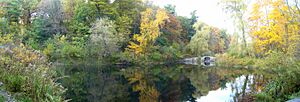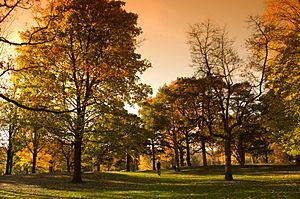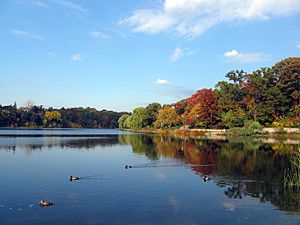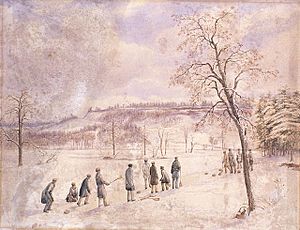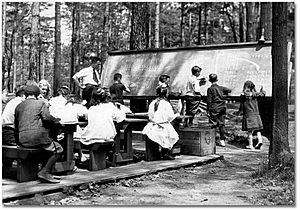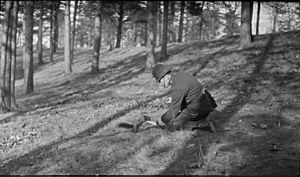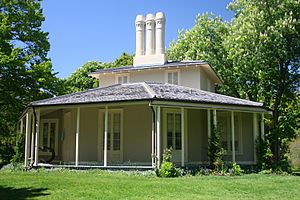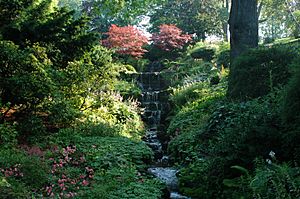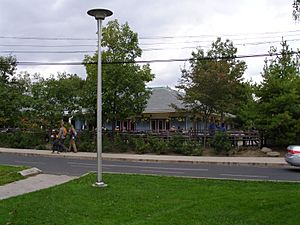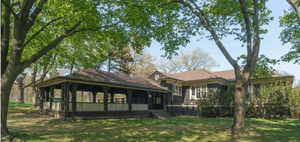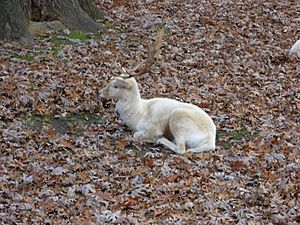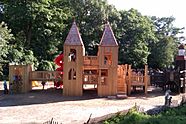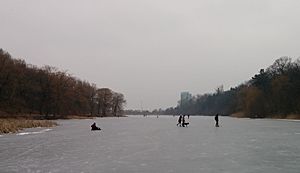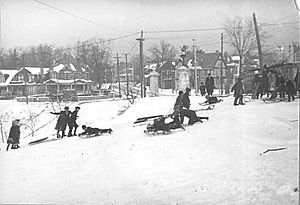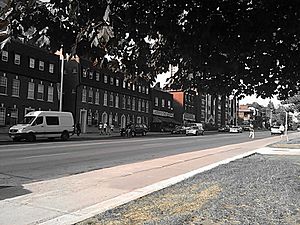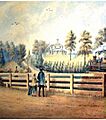High Park facts for kids
Quick facts for kids High Park |
|
|---|---|

High Park Hillside Gardens (2017)
|
|
| Lua error in Module:Location_map at line 420: attempt to index field 'wikibase' (a nil value). | |
| Type | Urban park |
| Location | 1873 Bloor Street West, Toronto, Ontario, Canada |
| Area | 398 acres (161 ha) |
| Created | 1876 |
| Owned by | City of Toronto |
| Operated by | Toronto Parks, Forestry & Recreation |
| Public transit access | High Park and Keele stations |
High Park is a huge and exciting municipal park in Toronto, Ontario, Canada. It's a special place that mixes fun activities with beautiful nature. You can find sports fields, gardens, playgrounds, and even a zoo here! About one-third of the park is still wild, with a rare type of forest called an oak savannah. High Park first opened to the public in 1876. It was created thanks to a generous gift of land from John George Howard to the City of Toronto. The park covers about 161 hectares (398 acres), making it the second-largest city park in Toronto.
High Park is located west of downtown Toronto, near Humber Bay. The City of Toronto takes care of it. The park stretches from Bloor Street West in the north down to The Queensway, which is close to Lake Ontario. On its west side, you'll find Ellis Park Road and Grenadier Pond. On the east, it's bordered by Parkside Drive.
Contents
- Exploring High Park's Natural Beauty
- High Park's Rich History
- Fun Things to Do in High Park
- Recreation and Sports in High Park
- Friends of the Park: Volunteers Making a Difference
- Neighborhoods Around High Park
- Monuments and Sculptures in High Park
- How to Get to High Park
- Images for kids
Exploring High Park's Natural Beauty
High Park has a hilly landscape with two deep valleys, called ravines, that run from north to south. Many of the natural parts of the park are considered important natural areas by the province.
The Eastern Ravine: A Hidden Creek and Ancient River
The eastern ravine is a long valley that runs north to south through the park. It follows a small creek and several ponds. A thick forest starts at the park's northeast corner, near Bloor and Keele Streets. The creek begins at ponds fed by springs, like Howard Pond and Ridout Pond. It then flows south through the ravine along Spring Creek Road.
Further south, the ravine becomes less forested. Here you'll find picnic areas, the adventure playground, and the zoo. Upper Duck Pond, near the adventure playground, is home to many kinds of ducks, including beautiful wood ducks. Sometimes, large Great blue herons can be seen here and at Lower Duck Pond. The water from Lower Duck Pond flows through pipes south to Lake Ontario.
Discovering an Ancient Underground River
In 2003, something amazing was found in the eastern ravine. City workers were capping two wells at a pond when water, sand, and rocks shot 15 metres into the air! This showed strong evidence of the Laurentian River, an ancient river that existed before the last ice age. Geologists finally found the end of this old river system, which starts near Georgian Bay. This river flows 50 metres below the surface in solid rock and has been untouched for thousands of years.
The Central Plain: Home to Rare Oak Savannah
The central part of High Park is a large flat area. It covers most of the northern boundary and narrows as it goes south towards Colborne Lodge, which overlooks Lake Ontario. While much of this area has picnic spots, gardens, and sports fields, it also has a special open habitat called an oak savannah. This type of habitat is very rare in Ontario.
What is an Oak Savannah?
The tall black oak trees you see all over High Park are a key part of this habitat. Many of these trees are over 150 years old! The City of Toronto and volunteer conservationists carefully look after the savannah. Forested areas in High Park are kept as natural as possible, with fallen trees left to decay. Controlled burns are sometimes done to copy natural forest fires, which help the oak trees grow. Volunteers also remove plants that are not native to the area. However, you can still find some non-native trees like Colorado spruce and Scots pine.
Grenadier Pond: A Large Body of Water
Grenadier Pond is a big pond, about 14.2 hectares in size, located on the western side of the park. It got its name from the soldiers (Grenadiers) who were stationed in the Town of York in the 1800s and used the pond for fishing.
Myths and Fishing at Grenadier Pond
There are two local stories about the pond. One says that British Grenadiers fell through the thin ice while trying to cross it during the War of 1812. However, the Grenadier Guards were not in Fort York at that time. Another story says the pond is "bottomless" because it's so deep and muddy. Fishing is still a popular activity here. You can catch fish like largemouth bass, black crappie, and carp. The fish caught in the pond are safe to eat, and fishing contests are sometimes held.
Improving the Pond's Health
Efforts have been made to make the pond healthier. Grenadier Pond gets some of its water from Wendigo Creek and underground streams. The northern end of the pond was made more natural by building a wetland. This wetland helps filter the water that flows into the pond. The southern and southwestern shores were also naturalized, removing lawns and concrete to improve the pond's health and discourage Canada geese. Signs now ask people not to feed the waterfowl. Grenadier Pond is home to many birds and marsh animals. The pond's water flows out to Lake Ontario through pipes near Sir Casimir Gzowski Park. Along its eastern shore, you'll find High Park's hillside gardens and a grove of cherry trees.
At the northern end of the pond, there's a small part of Wendigo Creek, Wendigo Pond, and a children's playground. The creek and pond are likely named after the wendigo, a mythical creature from Algonquian stories. While Algonquins didn't live in the park, they likely used it for hunting, fishing, and growing corn.
High Park's Rich History
In 1836, a man named John George Howard bought 160 acres of land west of Toronto for $1,000. He built Colborne Lodge, a beautiful Regency-style cottage, in 1837 to be his home.
The Railway Arrives
In 1854, the railway came to the south of Howard's property. Howard sold a small strip of land to the Hamilton and Toronto Railway Company for £300. The sandy area separating Grenadier Pond from Lake Ontario was filled in to support the train tracks. Later, in 1891, another strip of land was sold to the Grand Trunk Railway for $1,000.
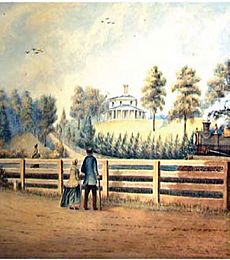
A Gift to the City
After a successful career as an architect and engineer for Toronto, Howard retired in 1855. In 1873, Howard and his wife decided to give their 120-acre property to the City of Toronto. They had a few conditions: they could continue living at Colborne Lodge, no alcohol could ever be served in the park, and the park had to be called "High Park" forever, for the free use of Toronto's citizens. The City also had to pay them a down payment and an annual pension. The city council agreed to these terms. At the time, it was hard to get to the property, so a new road, today's Spring Road and Centre Road, was built.
In 1876, 120 acres of Howard's land became the original park. The City also bought another 176 acres from Percival Ridout. The remaining 40 acres of Howard's property, including Colborne Lodge, went to the city after John Howard died in 1890. The Howards are buried in High Park, under a stone monument. Colborne Lodge is now a museum where you can see many of Howard's original belongings and his paintings of early Toronto.
Expanding High Park
The western part of High Park, including Grenadier Pond, was owned by the Ellis family and then the Chapman family. The Chapman family used Grenadier Pond to make ice for their Grenadier Ice Company until around 1920. In 1930, the Chapmans sold 71.8 acres, including the pond, to the City for $150,000.
High Park Forest School
The High Park Forest School opened in 1915. It was a public school for children who needed more physical activity. Classes were often held outdoors. Today, the High Park Nature Centre uses this building.
Ancient Burial Mounds
In 1921, ancient graves were found northwest of Grenadier Pond during road construction. Eight skeletons were found sitting up in red sand. These human remains were dated to between 2,500 BC and 800 AD, showing that Indigenous peoples lived in High Park long ago. The remains were covered in a red powder, similar to the customs of the Red Paint People and Red Ocher people.
Protecting the Park Today
In 1993, the High Park Citizens' Advisory Committee was formed. This volunteer group helps the City of Toronto take care of the park. They work to protect the park's environment, plant native species, and remove plants that don't belong there.
According to the Taiaiako'n Historical Preservation Society, there are 57 ancient Indigenous burial mounds in the park. In 2011, one site, known as "Snake Mound," was restored by the Society and the City of Toronto after it was damaged.
Saving the High Park Zoo
In 2012, the Toronto City Council decided to stop funding the High Park Zoo. A group called "Friends of the High Park Zoo" was formed to raise money and find sponsors. They successfully found a sponsor, the Honey Family Foundation, to help keep the zoo open.
Fun Things to Do in High Park
High Park has many interesting places and activities. These include the Colborne Lodge historical museum, beautiful gardens, the zoo, the Grenadier Cafe, and an outdoor amphitheatre. The park also has sports fields, a hockey rink, a swimming pool, tennis courts, playgrounds, nature trails, and picnic areas.
From spring to fall, you can ride a "trackless train" that tours the park every 30 minutes. The train stops at different points of interest, and you can buy tickets from the conductor.
Colborne Lodge: A Glimpse into the Past
Colborne Lodge is a historical museum located in a house built in 1836 by John George Howard. He was an important architect and engineer in Toronto and the first owner of High Park. Howard built this house for himself and his wife, Jemima Frances Meikle. The lodge became city property after his death in 1890. It sits on top of a hill with a great view of Lake Ontario.
Across the street from the lodge is Howard's tomb, a stone monument for him and his wife. The gate for the tomb's fence came from St Paul's Cathedral in London, England. It was designed by Christopher Wren in 1714, and Howard had it shipped to Toronto in 1875.
Beautiful Gardens to Explore
On the hill east of Grenadier Pond, near Colborne Lodge Road, you'll find lovely landscaped gardens. There's a 'rock garden' and 'sunken gardens' with fountains. At the bottom of the hill, near the pond, there's a large flower bed shaped like a maple leaf, which you can see from the top of the hill. This area used to be a popular spot for tobogganing.
High Park Children's Garden
North of Colborne Lodge is the High Park Children's Garden. It offers programs for schools and summer camps where kids can learn about growing plants. The Children's Garden and Colborne Lodge host an annual 'Harvest Festival' in the fall. This event includes crafts, pumpkin decorating, gardening displays, and wagon rides.
High Park Greenhouses
Northeast of the Grenadier Cafe are High Park's 109 allotment gardens, where people can grow their own plants. To the east, you'll find the High Park greenhouses. Since 1956, these greenhouses have grown millions of plants for Toronto's parks. They are not usually open to the public but sometimes offer tours.
Outdoor Sculptures
Further north, around the High Park Forest School, you can find several outdoor sculptures. These sculptures were created for an international art event in 1967. Some of them are placed within the forested areas.
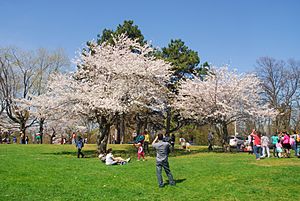
Cherry Trees: A Spring Spectacle
High Park has several groups of Japanese cherry trees that attract thousands of visitors every year in late April to early May. The main group of trees is along a road near Grenadier Cafe, leading down to Grenadier Pond. Other trees are along West Road, the pond shore, and west of the Jamie Bell playground.
The first Japanese Somei-Yoshino Cherry Tree was planted in High Park in 1959. It was a gift from the citizens of Tokyo. A plaque marks the spot where the Japanese ambassador presented the trees to Toronto's mayor, Nathan Phillips. In total, over 2,000 cherry trees were given to Toronto. More cherry trees were donated in 2001 and 2006. During the blooming season, the park roads are closed to cars because so many people come to see the beautiful blossoms.
Grenadier Cafe: A Place to Eat and Relax
The Grenadier Cafe is a restaurant with 300 seats and an outdoor patio. It's located in the center of the park. The restaurant opened in 1958. Because of the rules set by the Howards when they gave the land to the city, High Park is the only "dry" area in Toronto, meaning the Cafe cannot serve alcohol. The City of Toronto owns the restaurant, and a private company operates it.
During summer weekends, an outdoor organic produce market operates here. Twice a year, plant sales are held at the Cafe to raise money for conservation efforts. These plants are native to High Park and Ontario. The Cafe is also used for community meetings. North of the cafe, you can find a labyrinth pattern marked on a concrete circle. It was installed in 2004.
High Park Nature Centre: Learning About Nature
The High Park Nature Centre, located in the Forest School building, offers programs all year round to help people learn about nature. They have programs for families, children, and adults, including nature walks and workshops. Volunteers also help the Centre by removing invasive plants in High Park to protect native species. In 2016, over 12,000 people participated in the Nature Centre's programs.
The Centre is run by High Park Initiatives, a non-profit organization. It was established in 1999.
High Park Zoo: Meet the Animals!
High Park Zoo is a small collection of animals located along Deer Pen Road. The zoo has animals like American bison, Barbary sheep, capybaras, emus, Highland cattle, llamas, Mouflon sheep, peacocks, reindeer, wallabies, and yaks in eleven separate areas. The zoo is open every day from 7:00 a.m. until dusk. On weekends from March to October, you can visit the llama pen to feed and pet the llamas. Chickens and rabbits are also available for children to interact with.
The zoo animals are cared for by staff from Toronto Parks, Forestry and Recreation Division and volunteers from "Friends of High Park Zoo." The zoo's costs are partly covered by donations from visitors and charitable foundations. The "Friends of High Park Zoo" group was formed after the City Council decided to stop funding the zoo in 2012. They are working on plans to improve the zoo.
Keeping animals in the park started in 1893 with deer. In 2015, a peacock escaped from the zoo and was seen around the neighborhood for several weeks before returning on its own!
The Famous Capybaras
In May 2016, a pair of capybaras escaped from the zoo. People reported seeing them all over the city! On June 6, they were still free, and a Twitter account was even created for them. One was recaptured on June 12, and the second on June 28. Because of their adventure, they were nicknamed Bonnie and Clyde. In 2017, Bonnie and Clyde had three baby pups. The pups were named Geddy, Alex, and Neil, after the members of the Toronto rock band Rush.
Shakespeare in High Park: Outdoor Theatre
During the summer, the Canadian Stage Company performs plays by William Shakespeare in the park's amphitheatre. The amphitheatre is on the hillside east of the Grenadier Cafe and can seat hundreds of people. This annual event, called "Shakespeare in High Park," is very popular with people in Toronto.
Recreation and Sports in High Park
High Park has two main playgrounds for children. There's one in the northwest part of the park with a wading pool, picnic areas, and a snack bar. In the southeast corner, an 'adventure playground' was built by volunteers in 1999. It's named after Jamie Bell, a volunteer who first thought of the idea. In March 2012, part of the wooden playground was burned down. Volunteers rebuilt the castle part of the playground in July 2012. There's also a smaller play area just north of Grenadier Pond.
Dogs are welcome in the park! There's a large "off-leash" area northeast of the Grenadier Cafe where dogs can run free. In other parts of the park, dogs must be on a leash.
Trails and Winter Fun
High Park has unpaved dirt trails for hikers and walkers only. Cycling is not allowed on these trails to protect the environment. Some former roads in the park are now closed to cars but are still open for walking and cycling. In the winter, the hiking paths are used for cross-country skiing and snowshoeing.
Swimming and Skating
A city swimming pool complex is open during the summer. It has a water slide, a splash pad, and a shallow area. There is no fee to use the pool, and lifeguards are on duty.
Skating on Grenadier Pond was banned for a while, but it was always a favorite spot for skating and hockey. In 2015, the City Council decided to fund a program to monitor the ice and allow skating again. Ice conditions are now checked every year, and the information is posted on the City of Toronto's website. Grenadier Pond is the only open body of water in Toronto where the city allows skating.
Tobogganing
Tobogganing used to be very popular in the park. Now, it's mainly done on the hill at Howard Park Avenue and Parkside Drive.
Sports Facilities for Everyone
In the central area of the park, there are two soccer fields and three baseball diamonds. One of the baseball diamonds is home to the High Park baseball organization, which offers "Little League" programs for children. The smallest diamond is for T-Ball, and the larger field is for older players. In the winter, an ice hockey ice rink is open north of High Park Pool. The rink was updated in 2009 with donations from the Toronto Maple Leafs and Home Depot.
There are also several tennis courts in two locations. The High Park Tennis Club operates concrete courts along Colborne Lodge Road. The Howard Park Tennis Club operates courts and a clubhouse along Parkside Drive.
High Park was even used for cycling events during the 2017 Invictus Games, a sports event for injured military veterans.
Friends of the Park: Volunteers Making a Difference
The Volunteer Stewardship Program (VSP) is a group of volunteers who work with the City of Toronto to protect and restore the natural areas of High Park. This includes the large oak savannah areas and the plants and animals that live there. In spring, summer, and fall, volunteers plant, collect seeds, and remove invasive species. In winter, they have educational presentations and work in the greenhouses. The High Park Natural Environment Committee also advises the city on environmental issues in the park. These groups have a website, highparknature.org, with lots of information about High Park.
Neighborhoods Around High Park
High Park gives its name to two neighborhoods in Toronto: "High Park–Swansea" and "High Park North". High Park-Swansea is west of Roncesvalles Avenue, north to Bloor Street, and west to the Humber River. This area includes High Park itself. High Park North is east of Runnymede Road, north of Bloor Street, up to Annette Street and Humberside Avenue, and east to the railway lines.
These areas were mostly built after 1900 and have many detached or semi-detached homes. North of High Park, there are also several large apartment buildings. People living north and east of the park usually call their neighborhood High Park.
To the west is Swansea, which used to be a village centered around a metal factory. South of High Park is the Sunnyside shoreline on Lake Ontario. Along the lake, you'll find beaches, playgrounds, wading pools, and the Sunnyside Bathing Pavilion. The area east of High Park and south of Bloor Street is also known as Roncesvalles.
Monuments and Sculptures in High Park
High Park has several monuments and sculptures:
- A monument to John G. and Jemima Howard, who gave the park land to the city.
- The Lesya Ukrainka monument by Mykhailo Chereshniovsky, built in 1975.
- A Portuguese stone cross (padrão), built in 1978 to celebrate the 25th Anniversary of the Portuguese Community in Canada.
In 1967, an area east of Colborne Lodge Road was the site of the Toronto International Sculpture Symposium. Many sculptures were installed there. Five of the original ten permanent sculptures are still in High Park:
- The Hippie, by William Koochin, 1967
- Midsummer Night's Dream, by Wessel Couzijn, 1967
- November Pyramid, by Bernard Schottlander, 1967
- The Temple, by Hubert Dalwood, 1967
- Three Discs, by Menashe Kadishman, 1967
How to Get to High Park
High Park is easy to reach by public transit (TTC):
- You can take the subway to High Park or Keele stations on the Bloor–Danforth line.
- The 501 streetcar, 506 streetcar, and 80 Queensway bus routes also go to the park.
- The 30B Lambton bus loops inside the park from Victoria Day to Labour Day.
You can drive to most parts of the park, but some roads are closed to cars. There are parking lots at the Bell playground and zoo, Colborne Lodge, Grenadier Cafe, High Park pool, and the northwestern children's playground. On Sundays in the summer, the park roads are closed to car traffic.
You can also walk or bike to the park from nearby neighborhoods. The Martin Goodman Trail along Lake Ontario also leads to points south of the park.
Images for kids
-
Colborne Lodge in 1865. Several years later, in 1873, Howard would bequeath the property to the City of Toronto as an urban park.
-
Japanese cherry trees, the oldest planted in 1959.
-
Toronto Transit Commission streetcar at High Park Loop.


